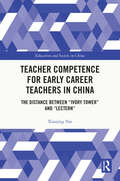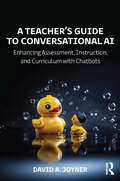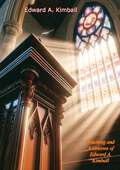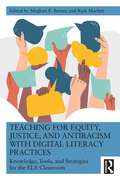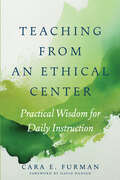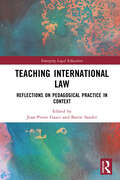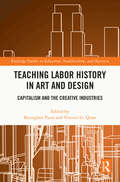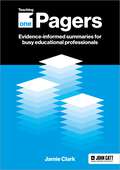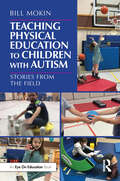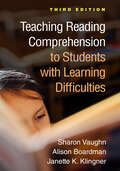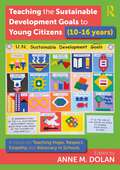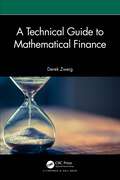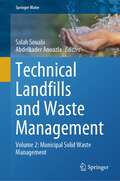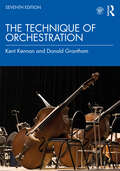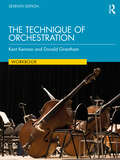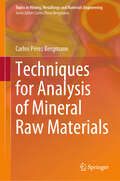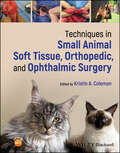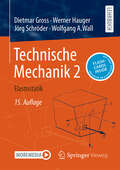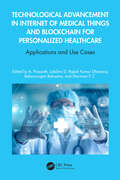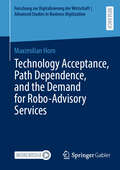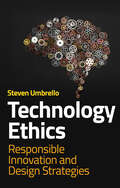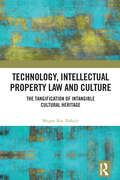- Table View
- List View
Teacher Competence for Early Career Teachers in China: The Distance between “Ivory Tower” and “Lectern” (ISSN)
by Xiaojing YanExamining the teacher education landscape in China, Xiaojing Yan focuses on how early career teachers (ECTs) build their competence during the initial years of teaching, challenges that come with teacher training and pathways to improve teacher competence.Although there is a growing trend in China to focus on teacher quality and professional development, teacher competence varies across teacher groups: ECTs, in particular, face a variety of challenges in the initial period. Using a qualitative-based approach, Yan examines 55 teacher education policies and 3 education laws between 1949 and 2019 in China. The chapters offer valuable insights into teacher education policy and practice, as well as teachers' professional development strategies and competence growth at the secondary level. With teacher’s needs in mind, this book provides a framework for policy development and teaching implementation, as well as for teachers' practices and effective professional learning.Discussing critical issues and opportunities in the development of ECTs competence, this book will appeal to researchers, students and practitioners across the fields of teacher education and professional learning development. It will also be relevant and accessible to policymakers involved in education and teacher training.
A Teacher’s Guide to Conversational AI: Enhancing Assessment, Instruction, and Curriculum with Chatbots
by David A. JoynerA Teacher’s Guide to Conversational AI explores the practical role that language-based artificial intelligence tools play in classroom teaching, learning experiences, and student assessment. Today’s educators are well aware that conversational and generative AI—chatbots, intelligent tutoring systems, large language models, and more—represent a complex new factor in teaching and learning. This introductory primer offers comprehensive, novice-friendly guidance into the challenges and opportunities of incorporating AI into K-12 schools and college classes in ways that are appropriate, nourishing to students, and outcomes-driven.Opening with an informative overview of the foundational properties, key terminology, and ethical considerations of these tools, the book offers a coherent and realistic vision of classrooms that are enhanced, rather than stymied, by AI systems. This includes strategies for:· designing assessments that are conducive to students’ beneficial use of AI while mitigating overreliance or dishonesty;· using AI to generate lesson examples for student critique or custom content that reinforces course principles;· leveraging chatbots as a co-instructor or a tutor, a guide during student-driven learning, a virtual debate or brainstorming partner, and a design project; and· creating course content, lesson plans and activities, expanded language and accessibility options, and beyond. Through the depth of understanding and applied approach provided in these chapters, teachers and leaders in training and in service, alongside private tutors, college instructors, and other educators, will be better prepared to future-proof their efforts to serve new generations of learners.
Teaching and Addresses of Edward A. Kimball
by Edward A. KimballExplore the profound insights and transformative teachings of one of Christian Science’s most influential figures with Teaching and Addresses of Edward A. Kimball. This compelling collection brings together the essential writings and speeches of Edward A. Kimball, offering readers a deep dive into the spiritual wisdom and practical guidance that have inspired countless individuals on their spiritual journeys.Edward A. Kimball, a prominent Christian Science teacher and lecturer, was known for his clear and compelling articulation of the principles of Christian Science. This anthology captures the essence of his teachings, providing a comprehensive overview of his views on spiritual healing, faith, and the application of Christian Science principles to everyday life.Teaching and Addresses of Edward A. Kimball covers a wide range of topics, from the foundational beliefs of Christian Science to practical advice on how to live a spiritually enriched and healthful life. Kimball’s writings emphasize the importance of understanding the divine laws of God, the nature of true health and harmony, and the power of spiritual thought to effect positive change.The book is organized to present Kimball’s teachings in a coherent and accessible manner, making it an invaluable resource for both newcomers to Christian Science and those seeking to deepen their understanding of its principles. His eloquent addresses and insightful essays provide readers with a roadmap for spiritual growth, encouraging them to cultivate a closer relationship with God and to experience the healing power of divine Love.This Book is an essential addition to the library of anyone interested in Christian Science, spiritual healing, and the pursuit of a deeper understanding of divine truth. Edward A. Kimball’s legacy of wisdom and compassion continues to guide and uplift readers, offering timeless insights into the path of spiritual enlightenment and healing.
Teaching Architecture: The New Age of Digital Design (Routledge Focus on Design Pedagogy)
by Sadiyah GeyerIn the post-COVID era, understanding the profound impact of digital technologies on design pedagogy is crucial. This book delves into experimental design education, showcasing projects utilising technology to transform creative and analytical processes.Emphasising the potential for digital-era technologies to create novel educational opportunities, the book addresses recent global events and their role in minimising educational disruptions in the evolving hybrid educational landscape. Each chapter offers case studies exploring digital technology's influence across architectural education, spanning interior design, urban planning, parametric digital design, architectural conservation, and design analysis. Contributors envision the hybrid virtual design studio’s future and discuss the collaborative role of digital technologies in urban design projects. The book analyses contemporary parametric design processes and machine learning through innovative historical case studies, examining new technologies in architectural conservation.With case studies from diverse locations, including South Africa, Turkey, the UK, and the United States, the book provides a global perspective on the influences and potential futures of digital technologies in architecture. Essential for those interested in the future of spatial design education, this book illuminates the pivotal role of technology in shaping its trajectory.
Teaching for Equity, Justice, and Antiracism with Digital Literacy Practices: Knowledge, Tools, and Strategies for the ELA Classroom
by Meghan E. Barnes Rick MarlattTo embrace today’s culturally and linguistically diverse secondary English Language Arts (ELA) classrooms, this text presents ways in which teachers can use digital tools in the service of antiracist teaching and developing equity-oriented mindsets in teaching and learning.Addressing how the use of digital tools and literacy practices can be woven into current ELA curricula, and with consistent sections, each chapter covers a different aspect of digital tool use, including multimodal texts, critical media literacies, connection-building, and digital composing. Understanding that no classroom is a monolith, Barnes and Marlatt’s timely text presents practical applications and resources suitable for different environments, including urban and rural contexts.The volume is essential reading in courses on ELA/literacy methods and multicultural education.
Teaching from an Ethical Center: Practical Wisdom for Daily Instruction
by Cara E. FurmanA methodology for using philosophy to guide teaching preparation and practice
Teaching International Law: Reflections on Pedagogical Practice in Context (ISSN)
by Barrie Sander Jean-Pierre GauciThe practice of teaching international law is conducted in a wide range of contexts across the world by a host of different actors – including scholars, practitioners, civil society groups, governments, and international organisations.This collection brings together a diversity of scholars and practitioners to share their experiences and critically reflect on current practices of teaching international law across different contexts, traditions, and perspectives to develop existing conversations and spark fresh ones concerning teaching practices within the field of international law. Reflecting on the responsibilities of teachers of international law to engage with and confront histories, contemporary crises, and everyday events in their teaching, the collection explores efforts to decenter the teacher and the law in the classroom, opportunities for dialogical and critical approaches to teaching, and the possibilities of co-producing non-conventional pedagogies that question the mainstream underpinnings of international law teaching. Focusing on the tools and techniques used to teach international law to date, the collection examines the teaching of international law in different contexts. Traversing a range of domestic and regional contexts around the world, the book offers insights into both the culture of teaching in particular domestic settings, aswell as the structural challenges and obstacles that arise in terms of who, what, and how international law is taught in practice.Offering a unique window into the personal experiences of a diversity of scholars and practitioners from around the world, this collection aims to nurture conversations about the responsibilities, approaches, opportunities, and challenges of teaching international law.
Teaching Labor History in Art and Design: Capitalism and the Creative Industries (Routledge Studies in Education, Neoliberalism, and Marxism)
by Kyunghee Pyun Vincent G. QuanDrawing from American history, fashion design, history of luxury, visual culture, museum studies, and women’s history, among others, this book explores the challenges, rewards and benefits of teaching business and the labor history of art and design professions to those in higher education.Recognizing that artists and designers are no longer just creatives, but bosses, employees, members of professional associations, and citizens of nations that encourage and restrain their creative work in various ways, the book identifies a crucial need for art and design students to be taught the intricacies of these other roles, as well as how to navigate or challenge them. This empirically driven study features case studies in various pedagogical contexts, including museum exhibitions, group projects, lesson plans, discussion topics, and long-term assignments. The chapters also explore how the roles of designing and making became separated, how new technologies and the rise of mass production affected creative careers, the shifts back and forth between direct employment and freelancing, and the evolution of government interventions in creative fields.With a diverse and experienced range of contributors, and providing a unique set of conceptual tools to interpret, cope with, and react to the ever-changing conditions of capitalism, this volume will appeal to educators and researchers across education, history, art history, and sociology, with interests in experiential learning, capitalism, equity, social justice and neoliberalism.
Teaching Music Performance in Higher Education
by Helen Julia Minors;Stefan Östersjö;Gilvano Dalagna;Jorge Salgado CorreiaHigher Music Performance Education, as taught and learned in universities and conservatoires in Europe, is undergoing transformation. Since the nineteenth century, the master-apprentice pedagogical model has dominated, creating a learning environment that emphasises the development of technical skills rather than critical and creative faculties. This book contributes to the renewal of this field by being the first to address the potential of artistic research in developing student-centred approaches and greater student autonomy. This potential is demonstrated in chapters illustrating artistic research projects that are embedded within higher music education courses across Europe, with examples ranging from instrumental tuition and ensemble work to the development of professional employability skills and inclusive practices. Bringing together diverse and experienced voices working within Higher Music Education but often also as professional performers, this edited collection pairs critical reflection with artistic insight to present new approaches to curricula for teaching interpretation and performance. It calls for greater collaboration between Higher Education and professional music institutions to create closer bonds with music industries and, thereby, improve students’ career opportunities. Teaching Music Performance in Higher Education will appeal to scholars, performers, teachers, but also students whose interests centre on innovative practices in conservatoires and music departments.
Teaching One-Pagers: Evidence-informed summaries for busy educational professionals
by Jamie ClarkAsk any teacher and they would say workload is one of the biggest blockers to their professional development. Simply put, most teachers are time-poor and too busy to engage with educational research to improve their classroom instruction. One-pagers are ultra-concise, A4-sized summaries that share important ideas about good teaching. In this practical volume, Jamie Clark presents more than 55 evidence-informed one-pagers that help educators reflect on their practice, build pedagogical knowledge, and prompt professional conversations with colleagues.
Teaching Physical Education to Children with Autism: Stories from the Field
by Bill MokinThis book is an essential guide for how to teach fun and engaging physical education classes tailored to include the needs of autistic children and children with learning disabilities.With this practical guidebook detailing tested methods and best practices, teachers will be well equipped to support all students, including disabled students and those with varying support needs. Through a narrative lens that details children’s real-life journeys, and with key definitions and ready-to-use activities included throughout, Teaching Physical Education to Children with Autism presents a teacher’s first-hand account of what it’s like to teach students with diverse learning needs. Its comprehensive scope addresses all the practical challenges that educators may face in working with this population, including difficult behavior and disengagement. Detailing a myriad of solutions to try, along with flexible frameworks that can be applied to a myriad of physical education goals, this book is essential reading for any physical education teacher, special education teacher, and anyone wishing to create more equitable learning environments for children with varying learning needs.
Teaching Reading Comprehension to Students with Learning Difficulties (The Guilford Series on Intensive Instruction)
by Sharon Vaughn Janette K. Klingner Alison BoardmanNow in a revised and expanded third edition, this important resource helps teachers understand how good readers comprehend text and how best to support students who are struggling. It presents effective instructional methods for learners at all grade levels, including those with reading disabilities. Every chapter translates state-of-the-art research into practical classroom applications. All facets of comprehension are addressed, including assessment, vocabulary, background knowledge, and text structure. Chapters also cover English learners, intensive intervention, and content literacy. Utility as a teacher guide and course text is enhanced by sample lesson plans, graphic organizers, and chapter-opening study questions. New to This Edition *Chapter on text selection and text structure. *Chapter on teachers' frequently asked questions, providing specific, actionable advice. *More than twice as many sample lesson plans. *Revised throughout with the latest research and teaching techniques.
Teaching the Sustainable Development Goals to Young Citizens (10-16 years): A Focus on Teaching Hope, Respect, Empathy and Advocacy in Schools
by Anne M. DolanWith the current climate and economic crises, education for sustainability has never been more critical. This timely and essential book encourages readers to rethink our current values systems and to interrogate common assumptions about our world. Written for all educators with an interest in sustainability, chapters address several possible future scenarios for our planet, allowing readers to make more educated choices about sustainability and to transfer this knowledge to students within the classroom.Each chapter focuses on a specific Sustainable Development Goal. Beginning with a brief historical and theoretical introduction to contextualise the goal, chapters then showcase the practical activities, case studies and exemplars that teachers can adopt when teaching. Topics explored include, but are not limited to: Poverty Renewable energy Climate change Peace and justice Human rights Access to education This book is an essential classroom resource for any teacher or student teacher wishing to promote the Sustainable Development Goals and to teach for a better and brighter future.
A Technical Guide to Mathematical Finance (Chapman and Hall/CRC Financial Mathematics Series)
by Derek ZweigA Technical Guide to Mathematical Finance covers those foundational mathematical topics most important to an aspiring or professional quant. The text goes beyond a simple recitation of methods and aims to impart a genuine understanding of the fundamental concepts underpinning most of the techniques and tools routinely used by those working in quantitative finance.Features Suitable for professional quants and graduate students in finance, and mathematical/quantitative finance “Concept Refreshers” used throughout to provide pithy summaries of complex topics Step-by-step detail for formal proofs and mathematical descriptions
Technical Landfills and Waste Management: Volume 2: Municipal Solid Waste Management (Springer Water)
by Salah Souabi Abdelkader AnouzlaThis book examines the issue of solid waste generation and management as a worldwide phenomenon, focusing on strategies that facilitate the disposal and utilization of waste while ensuring environmental integrity and meeting the needs of future generations. The process of urbanization, particularly in densely populated cities, has resulted in a notable increase in the production of solid waste. Unfortunately, the current management system employed by the government, as well as the available resources and technical capabilities, is insufficient in effectively addressing this issue. As a result, the accumulation of solid waste in the environment continues to rise, causing adverse impacts on both the natural surroundings and human well-being. The contamination of the air, soil, and water directly stems from this mounting waste. To confront this global challenge, determined efforts are being made to manage and diminish the volume of solid waste, with the ultimate goal of safeguarding the environment and preserving the welfare of future generations. Furthermore, the book delves into various sustainable development approaches, such as Gasification and Ash Melting, Anaerobic Digestion, and Composition. Additionally, it highlights the recent advancements in these techniques by scientists, which contribute to promoting sustainable solid waste management.
The Technique of Orchestration: Pearson New International Edition
by Kent Kennan Donald GranthamThe Technique of Orchestration, Seventh Edition, is the definitive textbook on the study of orchestration, offering a concise, straight-to-the-point approach that prepares students to score their own compositions with confidence. Updated to reflect developments in instruments and orchestral best practices, this seventh edition features: Copious musical examples spanning the history of the orchestra Detailed descriptions of instruments and their distinctive characteristics Explanations of how to score chords and transcribe piano idioms Discussions on specialized ensembles and scoring techniques New musical examples have been added throughout and listening lists have been revised to include more music by women and composers of color, representing a diverse musical catalogue. Supported by an accompanying workbook of scores and scoring exercises (available separately), as well as a robust listening program keyed to the textbook, The Technique of Orchestration, Seventh Edition, is an accessible, essential, all-in-one resource for the student of orchestration.
The Technique of Orchestration Workbook
by Kent Kennan Donald GranthamThe Technique of Orchestration Workbook, Seventh Edition, accompanies the textbook of the same name—the definitive resource on the study of orchestration—providing musical excerpts, full scores, and scoring assignments to enrich the lessons learned in the textbook. Spanning an array of periods and styles, the musical examples collected here cover scoring techniques in the following sections: Strings Woodwinds Brass Scoring of Chords Transcribing Piano Music Scoring for Woodwinds, Horns, and Strings Percussion Harp and Keyboard Instruments Scoring for Full Orchestra Additional learning tools include transposition exercises, error detection drills, and discussions on harmonics, while the workbook pages are perforated throughout for ease of use in and out of the classroom. Featuring the music of Bach, Mozart, Brahms, Beethoven, Schumann, Copland, Bartók, and many more, The Technique of Orchestration Workbook, Seventh Edition, is an invaluable companion to the textbook.
Techniques for Analysis of Mineral Raw Materials (Topics in Mining, Metallurgy and Materials Engineering)
by Carlos Pérez BergmannThis book presents a comprehensive exploration of fundamental concepts crucial for assessing the industrial viability of raw materials. Each chapter delves into a phenomenological understanding of various techniques, placing practical insights at the forefront while minimizing reliance on complex mathematical formalism. While recognizing the importance of select mathematical formulations to underpin the underlying physical principles, the primary emphasis remains on accessibility and real-world applicability. Readers will gain a solid understanding of pivotal concepts, equipping them with the proficiency to articulate the symbiotic relationship between analytical techniques and the acquisition of commercially significant insights.
Techniques in Small Animal Soft Tissue, Orthopedic, and Ophthalmic Surgery
by Kristin A. ColemanPractical reference with tips and tricks for successfully performing common surgeries in small animal patients Designed to help general practitioners confidently perform surgery, Techniques in Small Animal Soft Tissue, Orthopedic, and Ophthalmic Surgery offers fast access to step-by-step procedures for the most common surgeries in small animal patients. This book discusses the relevant anatomy, brief pathophysiology, pre-operative considerations, potential complications, and treatment options and detailed techniques for a wide range of surgical procedures, as well as the equipment needed to perform them. Written by specialists from around the world, the 54 chapters each cover multiple treatment options or variations to techniques described in the literature, featuring soft tissue, orthopedic, and ophthalmic surgeries. Practical tips and tricks for success in the operating room applicable to technicians, general practitioners, and surgeons are included throughout the book. High-quality color photographs accompany the surgical descriptions, along with video clips demonstrating some of the techniques hosted on a companion website. Techniques in Small Animal Soft Tissue, Orthopedic, and Ophthalmic Surgery includes information on: Simple eyelid mass removal, steps for prolapsed third eyelid gland, surgery for successful entropion repair, and enucleation Brachycephalic obstructive airway syndrome in dogs and cats and various surgical interventions, how to address aural hematoma, pinnectomy, and total ear canal ablation and lateral bulla osteotomy Ventral bulla osteotomy, mandibulectomy, sialoadenectomy, thyroidectomy, unilateral cricoarytenoid lateralization, and peripheral lymph node extirpation Extracapsular suture stabilization for the cranial cruciate ligament-deficient stifle, medial patellar luxation repair, femoral head and neck ostectomy, and canine elbow dysplasia Limb amputation in companion animals, skin reconstruction options, digit amputation, gastropexy, gastrointestinal procedures, splenectomy, and liver biopsies And many more procedures! Techniques in Small Animal Soft Tissue, Orthopedic, and Ophthalmic Surgery covers common surgeries performed in general practice, giving general practitioners, veterinary students, and new surgeons practical tips and tricks from experienced surgeons in an easily referenced format.
Technische Mechanik 2: Elastostatik
by Dietmar Gross Jörg Schröder Werner Hauger Wolfgang A. WallDer Band Elastostatik ist der zweite Teil des vierbändigen Lehrbuchs; er erscheint nun in der 15. Auflage. Ziel des didaktisch ausgefeilten Werkes ist es, das Verständnis der wesentlichen Grundgesetze der Mechanik zu vermitteln und die Fähigkeit zu entwickeln, mit Hilfe der Mechanik Ingenieurprobleme zu formulieren und selbständig zu lösen. Es wurde ein möglichst einfacher Zugang zur Mechanik gewählt. Der dargestellte Stoff orientiert sich am Umfang der Mechanikkurse an deutschsprachigen Hochschulen und ist für alle Bachelor-, Master- und Diplomstudiengänge hervorragend geeignet. Das Buch enthält zahlreiche durchgerechnete Beispiele. Die neue Auflage erhält zusätzlich zahlreiche Flashcards, die das Verständnis fördern und das Lernen erleichtern. Band 1 behandelt die Statik, Band 3 die Kinetik und Band 4 die Hydromechanik, Elemente der Höheren Mechanik und die Numerischen Methoden; geeignet für Ingenieurstudenten aller Fachrichtungen an Universitäten und Hochschulen. Auf Grund des großen Erfolges ist die Lehrbuchreihe mittlerweile auch in englischer Sprache als dreibändiges Werk "Engineering Mechanics" erschienen. Zusätzliche Fragen per App: Laden Sie die Springer-Nature-Flashcards-App kostenlos herunter und nutzen Sie exklusives Zusatzmaterial, um Ihr Wissen zu prüfen. Die freundliche Aufnahme, welche dieses Buch gefunden hat, macht eine Neuauflage erforderlich. Sie wurde genutzt, um eine Reihe von Verbesserungen und Ergänzungen vorzunehmen. Außerdem wurden Text und Abbildungen dem neuen Springer Layout angepasst, welches erlaubt, eine attraktive E-Book Variante bereitzustellen. Die Zielgruppen Das Buch wendet sich an Studierende der Ingenieurwissenschaften aller Fachrichtungen an Universitäten und Hochschulen.
Technological Advancement in Internet of Medical Things and Blockchain for Personalized Healthcare: Applications and Use Cases
by Balamurugan Balusamy Rajesh Kumar Dhanaraj A. Prasanth D LakshmiTechnological Advancement in Internet of Medical Things and Blockchain for Personalized Healthcare presents an overview of the innovative concepts, technologies, and various biomedical applications of the Internet of Medical Things (IoMT).Features:• Provides insights into smart contracts, healthcare monitoring equipment, and the next generation of Internet of Things sensors to improve adherence to chronic disease management programs and patient health.• Discusses the IoMT for personalized healthcare, security, and privacy issues of the IoMT in the healthcare sector.• Elaborates on the opportunities and challenges of blockchain technology in the healthcare system.• Focuses on the convergence of the IoMT and blockchain for emerging personalized healthcare systems.• Presents techniques and methods to secure IoMT devices to protect them from cyberattacks.This book is primarily written for graduate students and academic researchers working in the fields of computer science and engineering, biomedical engineering, and electrical engineering.
Technological Innovations in Tropical Livestock Development for Environmental Sustainability and Food Security: Proceedings of the 4th International Conference on Improving Tropical Animal Production for Food Security (ITAPS 2023), 4–5 December 2023, Kendari, Indonesia
by Purnaning Dhian Isnaeni Mashitah Shikh Maidin Muh. Amrullah Pagala Widhi Kurniawan Asma Bio KimestriThis book contains the proceedings of the fourth International Conference on Tropical Animal Production for Food Security (ITAPS) exploring Technological Innovations in Tropical Livestock Development for Environmental Sustainability and Food Security.It discusses two interconnected issues: tropical livestock farming and environmental concerns, while addressing the adoption of innovative technologies and sustainable farming practices as a crucial step in addressing challenges related to tropical livestock farming. The contents of the proceedings include the latest research that can be applied in agricultural fields to improve the agriculture business, including topics such as: Leveraging environmentally friendly technologies to enhance production efficiency, manage waste effectively, and reduce carbon footprints Halal meat production in the modern era Availability of animal waste resources as alternative energy The book will be valuable to students, researchers, and professionals in the agricultural fields and science.
Technology Acceptance, Path Dependence, and the Demand for Robo-Advisory Services (Forschung zur Digitalisierung der Wirtschaft | Advanced Studies in Business Digitization)
by Maximilian HornThis book explores the effects of the previously ignored factors of path dependence and product features on technology acceptance with a focus on robo-advice. A newly developed model introduces path dependence to technology acceptance research allowing to explain previously unaccountable effects. An empirical test of the model using data from Germany and the USA elicits that path dependence influences the attitudes towards and demand for robo-advice. A process consisting of a market survey, a choice-based conjoint analysis, and a test in a technology acceptance model allows the structured investigation of the effects of product features on the demand for robo-advice. The results show that selected product features have effects on the demand for robo-advice and that it is essential to establish these effects empirically.
Technology Ethics: Responsible Innovation and Design Strategies (Philosophy Of Engineering And Technology Ser. #40)
by Steven UmbrelloTechnologies cannot simply be understood as neutral tools or instruments; they embody the values of their creators and may unconsciously reinforce systematic patterns of inequality, discrimination, and oppression.Technology Ethics shows how responsible innovation can be achieved. Demonstrating how design and philosophy converge, the book delves into the intricate narratives that shape our understanding of technology – from instrumentalist views to social constructivism. Yet, at its core, it champions interactionalism as the most promising and responsible narrative. Through compelling examples and actionable tools, this book unravels the nuances of these philosophical positions tailored to foster responsible innovation and thoughtful design. As our everyday lives further intertwine with technology, understanding and implementing these design principles becomes not just beneficial, but essential.This concise and accessible introduction is essential reading for students and scholars of philosophy of technology, engineering ethics, science and technology studies, human-machine communication, as well as policymakers.
Technology, Intellectual Property Law and Culture: The Tangification of Intangible Cultural Heritage
by Megan Rae BlakelyFocusing on cultural expressions that are most likely to intermingle with copyright law, trademark and IP-adjacent regulations, this book examines contemporary issues in technology, intellectual property law, and culture.Intangible Cultural Heritage can consist of traditional knowledge, songs, craftsmanship, dance, and other practices, as well as the associated cultural artefacts and spaces; a widely varied global living heritage, transmitted generationally, must be allowed to organically evolve, often defying the process of identification so desirable in the realm of legal protections. This nebulous essence is particularly ill-suited to modern legal frameworks that can conflate the creative outputs that copyright is meant to protect with shared cultural practices. Combining a legal perspective with historical tact, the book develops a theoretical model to track the interaction amongst these issues as well as to make policy recommendations based on the existing and projected possible future outcomes. Several chapters of the book will be dedicated to contemporary issues where this framework and interaction are currently developing, focussing on law and technology issues with archiving and museums, online platforms and copyright infringement, and communities and creative production in virtual worlds.The book will be of interest to students and scholars in the field of copyright law and intellectual property law.
